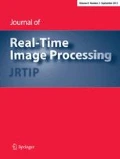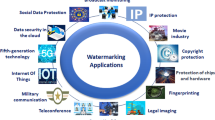Abstract
A novel deep neural network-based image watermarking method is presented to identify the source of digital data that is shared/forwarded on the internet using various messenger apps. The app that is used to share/communicate the image at the very first time is also identified in the proposed method. The ten-digit mobile number of the source (user) and identification data of particular messenger app (i.e. WhatsApp, Snapchat, Kik, Facebook messenger, etc.) is combined to get the text watermark signal. The part of the watermark signal representing specific mobile-based messenger application is obtained by randomizing the Walsh orthogonal codes using secret keys. To embed the watermark, the host image (shared/forwarded) is divided into blocks of equal size and then, slantlet transform is applied on each block. To get high reliability, three copies of the source information (user and app) are embedded during watermark embedding. Watermark extraction is performed using trained multilayer deep neural network. Furthermore, an optimal block selection logic is used to get improved results for real-time applications. The method is examined against various signal-processing attacks and high robustness with significant imperceptibility is attained. The method is also found to be fast enough for real-time applications. The prime objective of identifying the first user (source) and the shared/forwarded status (app detection) is successfully accomplished.













Similar content being viewed by others
References
Tsai, W.H.S., Men, R.L.: Social messengers as the new frontier of organization-public engagement: a WeChat study. Public Relat Rev 44(3), 419–429 (2018)
Dadashzadeh, M.: Social media in government: from eGovernment to eGovernance. J. Bus. Econ. Res. 8(11) (2010)
Heinonen, K.: Consumer activity in social media: managerial approaches to consumers’ social media behavior. J. Consum. Behav. 10(6), 356–364 (2011)
Whiting, A., Williams, D.: Why people use social media: a uses and gratifications approach. Qual. Mark Res. 16(4), 362–369 (2013)
Highfield, T., Leaver, T.: Instagrammatics and digital methods: studying visual social media, from selfies and GIFs to memes and emoji. Commun. Res. Pract. 2(1), 47–62 (2016)
Anandhan, A., Shuib, L., Ismail, M.A., Mujtaba, G.: Social media recommender systems: review and open research issues. IEEE Access 6, 15608–15628 (2018)
Ali, S., Islam, N., Rauf, A., Din, I., Guizani, M., Rodrigues, J.: Privacy and security issues in online social networks. Future Internet 10(12), 114 (2018)
Mahmoodi, J., Čurdová, J., Henking, C., Kunz, M., Matić, K., Mohr, P., Vovko, M.: Internet users’ valuation of enhanced data protection on social media: which aspects of privacy are worth the most? Front. Psychol. 9, 1516 (2018)
Rees, S., Mian, S., Grabowski, N.: Using social media in safety signal management: is it reliable? Ther. Adv. Drug Saf. 9(10), 591–599 (2018)
Isaak, J., Hanna, M.J.: User data privacy: Facebook, Cambridge analytica, and privacy protection. Computer 51(8), 56–59 (2018)
Lin, S.D., Chen, C.F.: A robust DCT-based watermarking for copyright protection. IEEE Trans. Consum. Electron. 46(3), 415–421 (2000)
Ali, M., Ahn, C.W.: Comments on “Optimized gray-scale image watermarking using DWT-SVD and firefly algorithm”. Expert Syst. Appl. 42(5), 2392–2394 (2015)
Ansari, I.A., Pant, M., Ahn, C.W.: ABC optimized secured image watermarking scheme to find out the rightful ownership. Optik 127(14), 5711–5721 (2016)
Lee, T.Y., Lin, S.D.: Dual watermark for image tamper detection and recovery. Pattern Recogn. 41(11), 3497–3506 (2008)
Ansari, I.A., Pant, M., Ahn, C.W.: SVD based fragile watermarking scheme for tamper localization and self-recovery. Int. J. Mach. Learn. Cybernet. 7(6), 1225–1239 (2016)
Shamsolmoali, P., Zareapoor, M., Jain, D.K., Jain, V.K., Yang, J.: Deep convolution network for surveillance records super-resolution. Multimed Tools Appl. 78(17), 23815–23829 (2019)
Jain, D.K., Shamsolmoali, P., Sehdev, P.: Extended deep neural network for facial emotion recognition. Pattern Recogn. Lett. 120, 69–74 (2019)
Dhiraj, Jain, D.K.: An evaluation of deep learning based object detection strategies for threat object detection in baggage security imagery. Pattern Recogn. Lett. 120, 112–119 (2019). https://doi.org/10.1016/j.patrec.2019.01.014
Gupta, B., Agrawal, D.P., Yamaguchi, S.: Handbook of research on modern cryptographic solutions for computer and cyber security. IGI Global, Pennsylvania (2016)
Mukkamala, S., Sung, A., Abraham, A.: Cyber security challenges: designing efficient intrusion detection systems and antivirus tools. In: Vemuri, Rao, V. (eds.) Enhancing computer security with smart technology, pp. 125–163. Auerbach, New York (2005)
Forstrom, H.S., Wojciechowski, E., Phadke, M. S.: U.S. Patent No. 7,260,722. Washington, DC: U.S. Patent and Trademark Office (2007)
Tsai, M. J., Lai, C. L., Liu, J.: Camera/mobile phone source identification for digital forensics. In: IEEE international conference on acoustics, speech and signal processing, 2007. ICASSP 2007, vol. 2, pp. II–221. IEEE (2007)
LeCun, Y., Bengio, Y., Hinton, G.: Deep learning. Nature 521(7553), 436 (2015)
Marblestone, A.H., Wayne, G., Kording, K.P.: Toward an integration of deep learning and neuroscience. Front. Comput. Neurosci. 10, 94 (2016)
Huang, W., Song, G., Hong, H., Xie, K.: Deep architecture for traffic flow prediction: deep belief networks with multitask learning. IEEE Trans. Intell. Transp. Syst. 15(5), 2191–2201 (2014)
Toderici, G., O’Malley, S.M., Hwang, S.J., Vincent, D., Minnen, D., Baluja, S., Sukthankar, R.: Variable rate image compression with recurrent neural networks. arXiv:1511.06085 (2015)
Liu, W., Wang, Z., Liu, X., Zeng, N., Liu, Y., Alsaadi, F.E.: A survey of deep neural network architectures and their applications. Neurocomputing 234, 11–26 (2017)
Mohsen, H., El-Dahshan, E.S.A., El-Horbaty, E.S.M., Salem, A.B.M.: Classification using deep learning neural networks for brain tumors. Future Comput. Inform. J. 3(1), 68–71 (2018)
Al Rahhal, M.M., Bazi, Y., AlHichri, H., Alajlan, N., Melgani, F., Yager, R.R.: Deep learning approach for active classification of electrocardiogram signals. Inf. Sci. 345, 340–354 (2016)
Cohen, G., Sapiro, G., Giryes, R.: DNN or k-NN: That is the Generalize vs. Memorize Question. arXiv:1805.06822 (2018)
Geng, J., Wang, H., Fan, J., Ma, X.: Deep supervised and contractive neural network for SAR image classification. IEEE Trans. Geosci. Remote Sens. 55(4), 2442–2459 (2017)
Hung, C.Y., Chen, W.C., Lai, P.T., Lin, C.H., Lee, C.C.: Comparing deep neural network and other machine learning algorithms for stroke prediction in a large-scale population-based electronic medical claims database. In: 2017 39th Annual International Conference of the IEEE Engineering in Medicine and Biology Society (EMBC), pp. 3110–3113 (2017)
Koutsoukas, A., Monaghan, K.J., Li, X., Huan, J.: Deep-learning: investigating deep neural networks hyper-parameters and comparison of performance to shallow methods for modeling bioactivity data. J. Cheminform. 9(1), 42 (2017)
Mayr, A., Klambauer, G., Unterthiner, T., Steijaert, M., Wegner, J.K., Ceulemans, H., Hochreiter, S.: Large-scale comparison of machine learning methods for drug target prediction on ChEMBL. Chem. Sci. 9(24), 5441–5451 (2018)
Zhang, F., Mao, Z., Huang, Y., Lin, X., Ding, G.: Deep learning models for EEG-based rapid serial visual presentation event classification. J. Inf. Hiding Multimed Signal Process 9(1), 177–187 (2018)
Korotcov, A., Tkachenko, V., Russo, D.P., Ekins, S.: Comparison of deep learning with multiple machine learning methods and metrics using diverse drug discovery data sets. Mol. Pharm. 14(12), 4462–4475 (2017)
Selesnick, I.W.: The slantlet transform. IEEE Trans. Signal Process. 47(5), 1304–1313 (1999)
Maitra, M., Chatterjee, A.: A Slantlet transform based intelligent system for magnetic resonance brain image classification. Biomed. Signal Process. Control 1(4), 299–306 (2006)
Mohammed, R.T., Khoo, B.E.: Image watermarking using slantlet transform. In 2012 IEEE Symposium on Industrial Electronics and Applications, pp. 281–286 (2012)
Wang, J., Liu, G., Dai, Y., Sun, J., Wang, Z., Lian, S.: Locally optimum detection for Barni’s multiplicative watermarking in DWT domain. Signal Process 88(1), 117–130 (2008)
Barni, M., Bartolini, F., De Rosa, A., Piva, A.: A new decoder for the optimum recovery of nonadditive watermarks. IEEE Trans. Image Process. 10(5), 755–766 (2001)
Chamlawi, R., Khan, A., Usman, I.: Authentication and recovery of images using multiple watermarks. Comput. Electr. Eng. 36(3), 578–584 (2010)
Conroy, N.J., Rubin, V.L., & Chen, Y.: Automatic deception detection: Methods for finding fake news. In: Proceedings of the 78th ASIS&T Annual Meeting: Information Science with Impact: Research in and for the Community. American Society for Information Science, p. 82 (2015)
Jagadeesh, B., Kumar, P.R., Reddy, P.C.: Robust digital image watermarking based on fuzzy inference system and back propagation neural networks using DCT. Soft. Comput. 20(9), 3679–3686 (2016)
Yen, C.T., Huang, Y.J.: Frequency domain digital watermark recognition using image code sequences with a back-propagation neural network. Multimed Tools Appl 75(16), 9745–9755 (2016)
Tandoc Jr., E.C., Ling, R., Westlund, O., Duffy, A., Goh, D., Zheng Wei, L.: Audiences’ acts of authentication in the age of fake news: a conceptual framework. New Media Soc. 20, 2745–2763 (2017)
Wang, J., Lian, S., Shi, Y.Q.: Hybrid multiplicative multi-watermarking in DWT domain. Multidimens. Syst. Signal Process. 28(2), 617–636 (2017)
Draganić, A., Marić, M., Orović, I., Stanković, S.: Identification of image source using serial-number-based watermarking under Compressive Sensing conditions. In: 2017 40th International convention on information and communication technology, electronics and microelectronics (MIPRO), pp. 1227–1232 (2017)
Mehta, R., Rajpal, N., Vishwakarma, V.P.: Robust image watermarking scheme in lifting wavelet domain using GA-LSVR hybridization. Int. J. Mach. Learn. Cybernet. 9(1), 145–161 (2018)
Parah, S.A., Loan, N.A., Shah, A.A., Sheikh, J.A., Bhat, G.M.: A new secure and robust watermarking technique based on logistic map and modification of DC coefficient. Nonlinear Dyn. 93(4), 1933–1951 (2018)
Srivastava, R., Kumar, B., Singh, A.K., Mohan, A.: Computationally efficient joint imperceptible image watermarking and JPEG compression: a green computing approach. Multimed. Tools Appl. 77(13), 16447–16459 (2018)
Singh, A.K., Kumar, B., Singh, S.K., Ghrera, S.P., Mohan, A.: Multiple watermarking technique for securing online social network contents using back propagation neural network. Future Gener. Comput. Syst. 86, 926–939 (2018)
Zhang, T., Li, X., Qi, W., Li, W., Guo, Z.: Real-time reversible data hiding based on multiple histogram modification. J. Real-Time Image Process. 16, 1–11 (2018)
Gao, Y., Wang, J., Shi, Y.Q.: Dynamic multi-watermarking and detecting in DWT domain. J. Real-Time Image Process. 16, 1–12 (2018)
Sharma, V., Mir, R.N.: An enhanced time efficient technique for image watermarking using ant colony optimization and light gradient boosting algorithm. J King Saud Univ Comput Inform Sci (2019). https://doi.org/10.1016/j.jksuci.2019.03.009
Sinhal, R., Ansari, I.A.: A source and ownership identification framework for mobile based messenger applications. Soft computing: theories and applications. Springer, Singapore (2019)
Akansu, A.N., Poluri, R.: Walsh-like nonlinear phase orthogonal codes for direct sequence CDMA communications. IEEE Trans. Signal Process. 55(7), 3800–3806 (2007)
Dinan, E.H., Jabbari, B.: Spreading codes for direct sequence CDMA and wideband CDMA cellular networks. IEEE Commun. Mag. 36(9), 48–54 (1998)
Sewaif, A.B., Al-Mualla, M., Al-Ahmad, H.: Walsh-coded signatures for robust digital image watermarking. In: TENCON 2004. 2004 IEEE region 10 conference, pp. 431–434, IEEE (2004)
Ansari, I.A., Pant, M., Ahn, C.W.: Artificial bee colony optimized robust-reversible image watermarking. Multimed Tools Appl. 76(17), 18001–18025 (2017)
Thabit, R., Khoo, B.E.: Robust reversible watermarking scheme using Slantlet transform matrix. J. Syst. Softw. 88, 74–86 (2014)
Thakkar, F.N., Srivastava, V.K.: A blind medical image watermarking: DWT-SVD based robust and secure approach for telemedicine applications. Multimed. Tools Appl. 76(3), 3669–3697 (2017)
Fridrich, J., Goljan, M.: Comparing robustness of watermarking techniques. In: Security and watermarking of multimedia contents, vol. 3657, pp. 214–225. International Society for Optics and Photonics (1999)
Acknowledgements
This work was supported by Faculty Initiation Grant of PDPM Indian Institute of Information Technology Design and Manufacturing Jabalpur, India.
Author information
Authors and Affiliations
Corresponding author
Additional information
Publisher's Note
Springer Nature remains neutral with regard to jurisdictional claims in published maps and institutional affiliations.
Rights and permissions
About this article
Cite this article
Sinhal, R., Ansari, I.A. & Jain, D.K. Real-time watermark reconstruction for the identification of source information based on deep neural network . J Real-Time Image Proc 17, 2077–2095 (2020). https://doi.org/10.1007/s11554-019-00937-z
Received:
Accepted:
Published:
Issue Date:
DOI: https://doi.org/10.1007/s11554-019-00937-z




